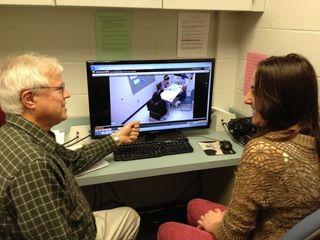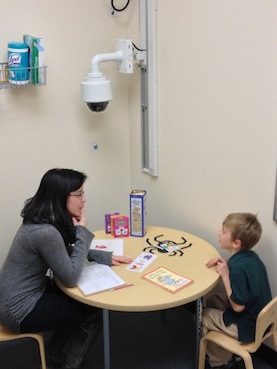
In its heyday, the old analog VCR-based camera system used by the Communicative Disorders department at the University of Wisconsin-River Falls (UWRF) campus was considered an advanced teaching tool.
- The system plays an integral role in the department’s Speech, Language and Hearing Clinic. In the clinic, which functions as a learning lab, graduate students work with real clients from the community who have speech and language disorders ranging from stuttering and aphasia to Asperger’s syndrome.
- Supervising professors watch each session from an observation room through one-way glass or from their office on live video streams. The video is also recorded, so the professors can review and evaluate the students’ work afterwards. Groups of undergraduates often use archived video as part of their coursework, and professors play video clips from various therapy sessions during class to illustrate specific speech and language disorders.
- However, the analog system was beginning to show its age. Breakdowns were becoming more frequent, and the system was too complex for instructors to troubleshoot themselves. When equipment failed, it would be out of commission until in-house or third-party technicians could make a service call.
- Even when the system was operational, “it was cumbersome for professors to record and review stacks of VHS tapes, find the exact sessions they wanted to use, queue them up, and then take them up to their classrooms to show and hope they worked on the classroom VCR,” explained Sarah Smits, Associate Clinical Professor in the Department of Communicative Disorders at the University of Wisconsin River Falls. Consequently, many teaching opportunities were missed.
- With the system reaching the end of its life, the department wanted to replace it with a state-of-the-art network-based video system. Based on a similar system at the UW-Eau Claire campus, River Falls selected a turnkey solution from PDS, Inc. CompView, an audio-visual systems integrator, installed the intuitive Intelligent Stream Recorder software and HDTV-quality fixed and pan/tilt/zoom (PTZ) network cameras from Axis to capture therapy sessions and stream the recordings to the PDS-furnished ISR server in the campus data center
- Bringing Training Tools Into the Digital Age
CompView replaced the old standard-definition cameras in the four pediatric therapy rooms with 1080p HDTV-quality AXIS Q6035 PTZ Dome Network Cameras with two-way audio capability. The cameras are mounted on vertical bars so that clinicians can manually move them anywhere between 18 inches and four feet from the floor. This is critical for capturing close-ups of children’s faces and their verbalizations as they play on the floor with the therapist.
Because adults tend to be move around less than children during therapy, the department chose fixed 1080p/3MP AXIS P1346 Network Cameras with two-way audio for the four adult therapy rooms. According to Smits, though, they’re considering changing one or two of those cameras to Axis PTZ models at some point for more observational flexibility.
“It’s amazing how much simpler the network camera system is,” said Erin Shannon, System Designer for CompView. “The old analog system needed two full racks of audio/video gear plus countless feet of cabling to support it. And then each TV monitor needed its own associated VCR. The new PDS/Axis system simply plugged directly into the building’s existing network through a network switch and streams the video to the main server several buildings away.
“Professors just log onto the network from their desktops to turn on the cameras, control the PTZ cameras, and retrieve stored video. Groups of students can sit in front of large screen HD monitors and watch live sessions or pull up recorded sessions from the archives.”
The Intelligent Stream Recorder software lets clinical students use free text or drop-down menus to classify the type of session being recorded, such as a client with a hearing loss. This makes it easy for a professor teaching a class about hearing loss to search the database for therapy sessions focused on that particular speech, language, or hearing disorder.
“Since video can be cued up with a simple click of the mouse, professors are now incorporating clips in their weekly classes on a regular basis,” said Sarah Smits. “That’s something they would have never done in the past, because it was just too cumbersome and time-consuming to find the segments they needed.”
In the past, most students only recorded two therapy sessions per client each semester, because it took so long to program a recording with the old analog system. Now that it takes less than five minutes to program the new network camera system, students are capturing every session during the entire semester. This gives them and their supervisors a more complete picture of their clinical progress.
Learning to Interact More Effectively
The streamlined operation of the new network camera system created an opportunity for more immediate feedback. Smits related the evaluation of a young child with delayed speech development. As Smits monitored the session live from her computer, she noticed that the mother was becoming increasingly upset about the tasks the student clinician was giving the child to do. The student, however, was focused on the child and completely unaware of the mother’s agitation.
“Immediately after the evaluation I brought the student into my office, cued up the recording of the session, and showed her what I had seen,” Smits said. “The mother’s facial expression said it all. The student instantly understood that she should have put the mother at ease by explaining the testing process and involving her in the tasks. It was a teachable moment that we might never have had with the old system because the VHS tapes were so inconvenient to deal with.”
Smits says that the department is also contemplating the value of sharing the recorded sessions with receptive parents to teach them how to practice speech and language skills more effectively at home with their children.
“The high-definition Axis cameras give students and supervisors the audio and video clarity they need to catch the nuanced interaction between patients and clinicians,” Smits said. “Because the IP system is so easy to use, it delivers an endless supply of teachable moments.”
Steve Surfaro is the security industry liaison for Axis Communications, Inc., and he works closely with top industry associations as well as local, state and national law enforcement for video best practices in all vertical markets, including education. He can be reached at steve.surfaro@axis.com.










